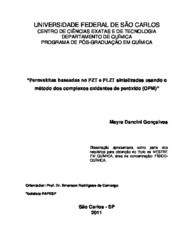| dc.contributor.author | Gonçalves, Mayra Dancini | |
| dc.date.accessioned | 2016-06-02T20:36:30Z | |
| dc.date.available | 2011-04-19 | |
| dc.date.available | 2016-06-02T20:36:30Z | |
| dc.date.issued | 2011-03-17 | |
| dc.identifier.citation | GONÇALVES, Mayra Dancini. Perovskites based on PZT e PLZT synthesized by means of the Oxidant Peroxo Method (OPM). 2011. 97 f. Dissertação (Mestrado em Ciências Exatas e da Terra) - Universidade Federal de São Carlos, São Carlos, 2011. | por |
| dc.identifier.uri | https://repositorio.ufscar.br/handle/ufscar/6488 | |
| dc.description.abstract | Were synthesized by the OPM, the solid solutions of Pb(Zr1-xTix)O3 with x = 0.8, 0.48 and 0.2, and also the lanthanum modified lead zirconate titanate compositions (Pb0.95La0.05) (Zr1-xTix)O3 with x = 0.8 and 0.2. This paper reports the first synthesis of PLZT by means of the OPM route. The techniques for X-ray diffraction and Raman spectroscopy at room temperature showed that the PZT and PLZT compositions Ti-rich have essentially tetragonal structure and the compositions Zr-rich are rhombohedral. Since the composition with x = 0.48 known as the morphotropic phase boundary (MPB) shows a mixture of both structures. Analysis by BET isotherms showed that the powders have high surface area even when thermally treated at 700 ° C, confirming its higher reactivity compared to powders obtained by other synthetic methods. At this temperature, images from scanning electron microscopy reveal the formation of aggregates of nanometric spherical particles already in the process of sintering due to diffusion of matter and formation of necks between them. Since these materials have great technological importance, the powders were conformed to the shape of discs and sintered in two types of ovens, conventional and microwave ones, for evaluation and comparison of morphological, structural and dielectric properties. The composition of PZT in the MPB showed dielectric constant higher than the values reported in the literature, both for the samples sintered in a conventional oven (12330) as for the sintered using microwave energy (17900). However, the Curie temperature also showed anomalous values of 460 and 465 ° C, respectively. It can be attributed to the influence of the absence or lower content of oxygen vacancies in the powders synthesized by means of the OPM route. | eng |
| dc.description.sponsorship | Universidade Federal de Minas Gerais | |
| dc.format | application/pdf | por |
| dc.language | por | por |
| dc.publisher | Universidade Federal de São Carlos | por |
| dc.rights | Acesso Aberto | por |
| dc.subject | Sinterização | por |
| dc.subject | Ferroelétricos | por |
| dc.subject | Cerâmica | por |
| dc.subject | Microondas | por |
| dc.title | Perovskitas baseadas no PZT e PLZT sintetizadas usando o método dos complexos oxidantes de peróxido (OPM) | por |
| dc.title.alternative | Perovskites based on PZT e PLZT synthesized by means of the Oxidant Peroxo Method (OPM) | eng |
| dc.type | Dissertação | por |
| dc.contributor.advisor1 | Camargo, Emerson Rodrigues de | |
| dc.contributor.advisor1Lattes | http://lattes.cnpq.br/7720754304065239 | por |
| dc.description.resumo | Foram sintetizadas pelo OPM, as solução sólidas do Pb(Zr1-xTix)O3 com x= 0,8; 0,48 e 0,2, além da síntese do titanato zirconato de chumbo modificado com lantânio de composições (Pb0.95La0.05)(Zr1-xTix)O3 com x=0,8 e 0,2. Este trabalho reporta pela primeira vez a síntese de PLZT pelo método OPM. À temperatura ambiente as técnicas de difração de raios X e espectroscopia Raman mostraram que as composições de PZT e PLZT ricas em titânio apresentam estrutura essencialmente tetragonal e as composições ricas em zircônio, estrutura romboédrica. Já a composição com x=0,48 conhecida como pertencente à região de contorno de fase morfotrópica (MPB) apresenta a mistura de ambas as estruturas. Análises por isotermas de BET mostraram que os pós apresentam alta área superficial mesmo quando tratadas térmicamente à 700 oC, confirmando sua maior reatividade comparada aos pós obtidos por outros métodos de síntese. Nesta temperatura imagens de microscopia eletrônica de varredura revelam a formação de agregados de partículas esféricas nanométricas já em processo de sinterização devido à difusão de matéria e formação de pescoços entre elas. Uma vez que esses materiais tem grande importância tecnologia, os pós foram conformados na forma de discos e sinterizadas em dois tipos de fornos, convencional e micro-ondas, para avaliação e comparação das propriedades morfológicas, estruturais e dielétricas. A composição de PZT no MPB apresentou constante dielétrica acima dos valores reportados na literatura, tanto para as amostras sinterizadas em forno convencional (12330) quanto para as sinterizadas com o uso de energia micro-ondas (17900). Entretanto a temperatura de Curie também apresentou valores anômalos, de 460 e 465 oC, respectivamente, podendo ser atribuída à influência da ausência ou baixa quantidade de vacâncias de oxigênio nos pós sintetizados pelo método OPM. | por |
| dc.publisher.country | BR | por |
| dc.publisher.initials | UFSCar | por |
| dc.publisher.program | Programa de Pós-Graduação em Química - PPGQ | por |
| dc.subject.cnpq | CIENCIAS EXATAS E DA TERRA::QUIMICA | por |
| dc.contributor.authorlattes | http://lattes.cnpq.br/9207706266657791 | por |
